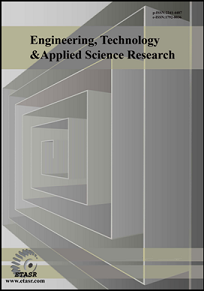Analysis of D2D Communication System Over κ-μ Shadowed Fading Channel
Abstract
Outage performance of a device-to-device (D2D) communication system in the presence of co-channel interference (CCI) is analyzed in this paper. Channels for the D2D and CCI signals are assumed to be κ-μ shadowed faded. Maximal ratio combining (MRC) and selection combining (SC) techniques are considered to combat fading conditions. Characteristic function (CF) expression of the D2D system in the presence of CCI is presented. Outage probability and success probability expressions are presented for the MRC and SC schemes. These outage probability and success probability expressions are functions of various CCI, path-loss and channel fading parameters. With the help of numerical results, effects of CCI on the performance of D2D communication system under different channel fading and path-loss conditions are discussed.
Keywords:
co-channel interference, D2D communication, κ-μ shadowed distribution, maximal ratio combining, selection combining, outage probabilityDownloads
References
H. H. Esmat, M. M. Elmesalawy, I. I. Ibrahim, “Adaptive Resource Sharing Algorithm for Device-to-Device Communications Underlaying Cellular Networks”, IEEE Communications Letters, Vol. 20, No. 3, pp. 530-533, 2016 DOI: https://doi.org/10.1109/LCOMM.2016.2517012
Y. J. Chun, S. L. Cotton, H. S. Dhillon, A. Ghrayeb, M. O. Hasna, “A Stochastic Geometric Analysis of Device-to-Device Communications Operating Over Generalized Fading Channels”, IEEE Transactions on Wireless Communications, Vol. 16, No. 7, pp. 4151-4165, 2017 DOI: https://doi.org/10.1109/TWC.2017.2689759
W. Song, Y. Zhao, W. Zhuang, “Stable Device Pairing for Collaborative Data Dissemination With Device-to-Device Communications”, IEEE Internet of Things Journal, Vol. 5, No. 2, pp. 1251-1264, 2018 DOI: https://doi.org/10.1109/JIOT.2018.2800904
K. Yang, S. Martin, C. Xing, J. Wu, R. Fan, “Energy-Efficient Power Control for Device-to-Device Communications”, IEEE Journal on Selected Areas in Communications, Vol. 34, No. 12, pp. 3208-3220, 2016 DOI: https://doi.org/10.1109/JSAC.2016.2624078
N. Vo, T. Q. Duong, H. D. Tuan, A. Kortun, “Optimal Video Streaming in Dense 5G Networks With D2D Communications”, IEEE Access, Vol. 6, pp. 209-223, 2018 DOI: https://doi.org/10.1109/ACCESS.2017.2761978
K. S. Ali, H. ElSawy, M. Alouini, “Modeling Cellular Networks With Full-Duplex D2D Communication: A Stochastic Geometry Approach”, IEEE Transactions on Communications, Vol. 64, No. 10, pp. 4409-4424, 2016 DOI: https://doi.org/10.1109/TCOMM.2016.2601912
L. Wang, H. Tang, H. Wu, G. L. Stuber, “Resource Allocation for D2D Communications Underlay in Rayleigh Fading Channels”, IEEE Transactions on Vehicular Technology, Vol. 66, No. 2, pp. 1159-1170, 2017 DOI: https://doi.org/10.1109/TVT.2016.2553124
M. Peng, Y. Li, T. Q. S. Quek, C. Wang, “Device-to-Device Underlaid Cellular Networks under Rician Fading Channels”, IEEE Transactions on Wireless Communications, Vol. 13, No. 8, pp. 4247-4259, 2014 DOI: https://doi.org/10.1109/TWC.2014.2314115
D. Marshall, S. Durrani, J. Guo, N. Yang, “Performance comparison of device-to-device mode selection schemes”, IEEE 26th Annual International Symposium on Personal, Indoor, and Mobile Radio Communications, Hong Kong, China, August 30 – September 2, 2015 DOI: https://doi.org/10.1109/PIMRC.2015.7343542
S. L. Cotton, “Human Body Shadowing in Cellular Device-to-Device Communications: Channel Modeling Using the Shadowed κ-μ Fading Model”, IEEE Journal on Selected Areas in Communications, Vol. 33, No. 1, pp. 111-119, 2015 DOI: https://doi.org/10.1109/JSAC.2014.2369613
J. F. Paris, “Statistical Characterization of κ-μ Shadowed Fading”, IEEE Transactions on Vehicular Technology, Vol. 63, No. 2, pp. 518-526, 2014 DOI: https://doi.org/10.1109/TVT.2013.2281213
I. S. Gradshteyn, I. M. Ryzhik, Table of Integrals, Series, and Products, 7th ed, Academic Press, 2007
A. Goldsmith, Wireless Communications, Cambridge University Press, 2005 DOI: https://doi.org/10.1017/CBO9780511841224
Downloads
How to Cite
License
Authors who publish with this journal agree to the following terms:
- Authors retain the copyright and grant the journal the right of first publication with the work simultaneously licensed under a Creative Commons Attribution License that allows others to share the work with an acknowledgement of the work's authorship and initial publication in this journal.
- Authors are able to enter into separate, additional contractual arrangements for the non-exclusive distribution of the journal's published version of the work (e.g., post it to an institutional repository or publish it in a book), with an acknowledgement of its initial publication in this journal.
- Authors are permitted and encouraged to post their work online (e.g., in institutional repositories or on their website) after its publication in ETASR with an acknowledgement of its initial publication in this journal.





